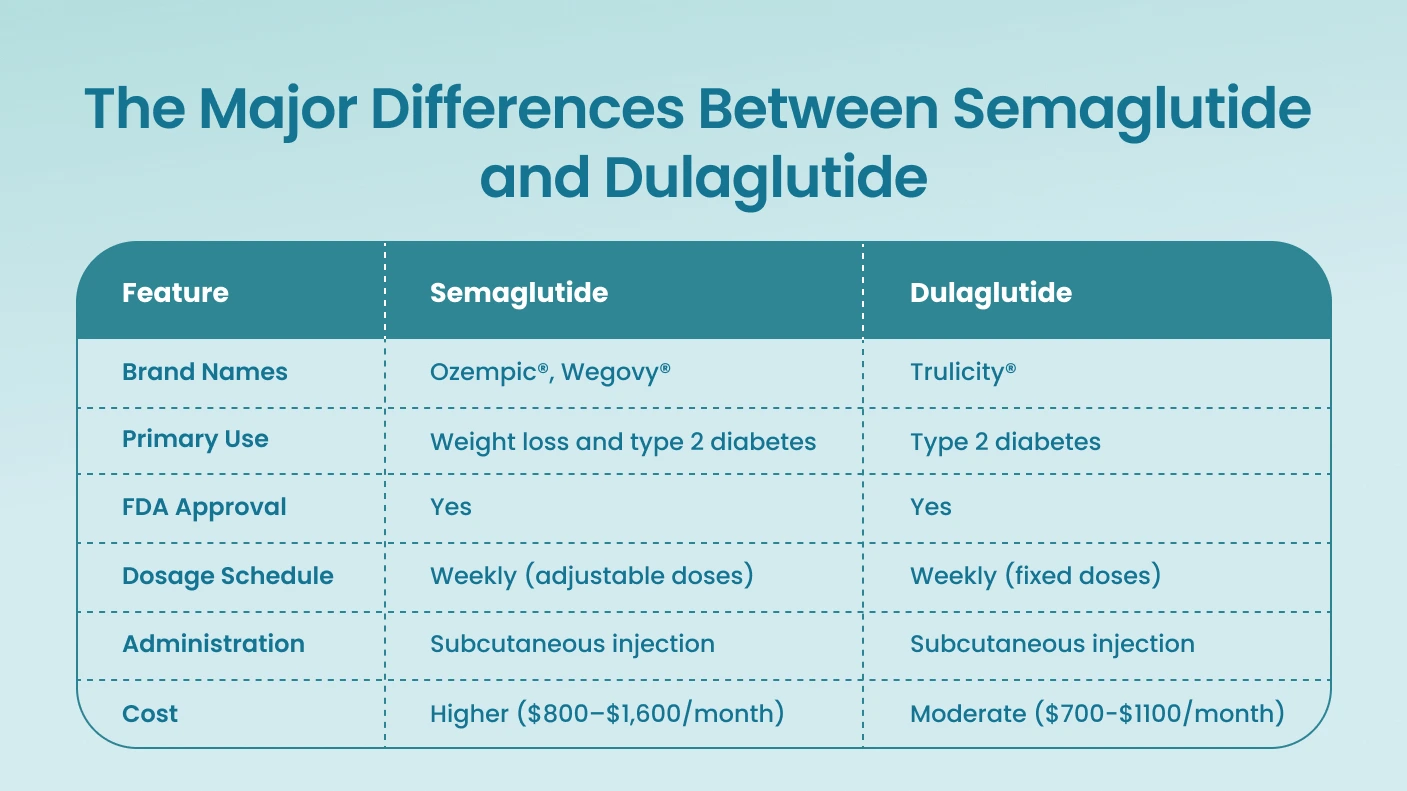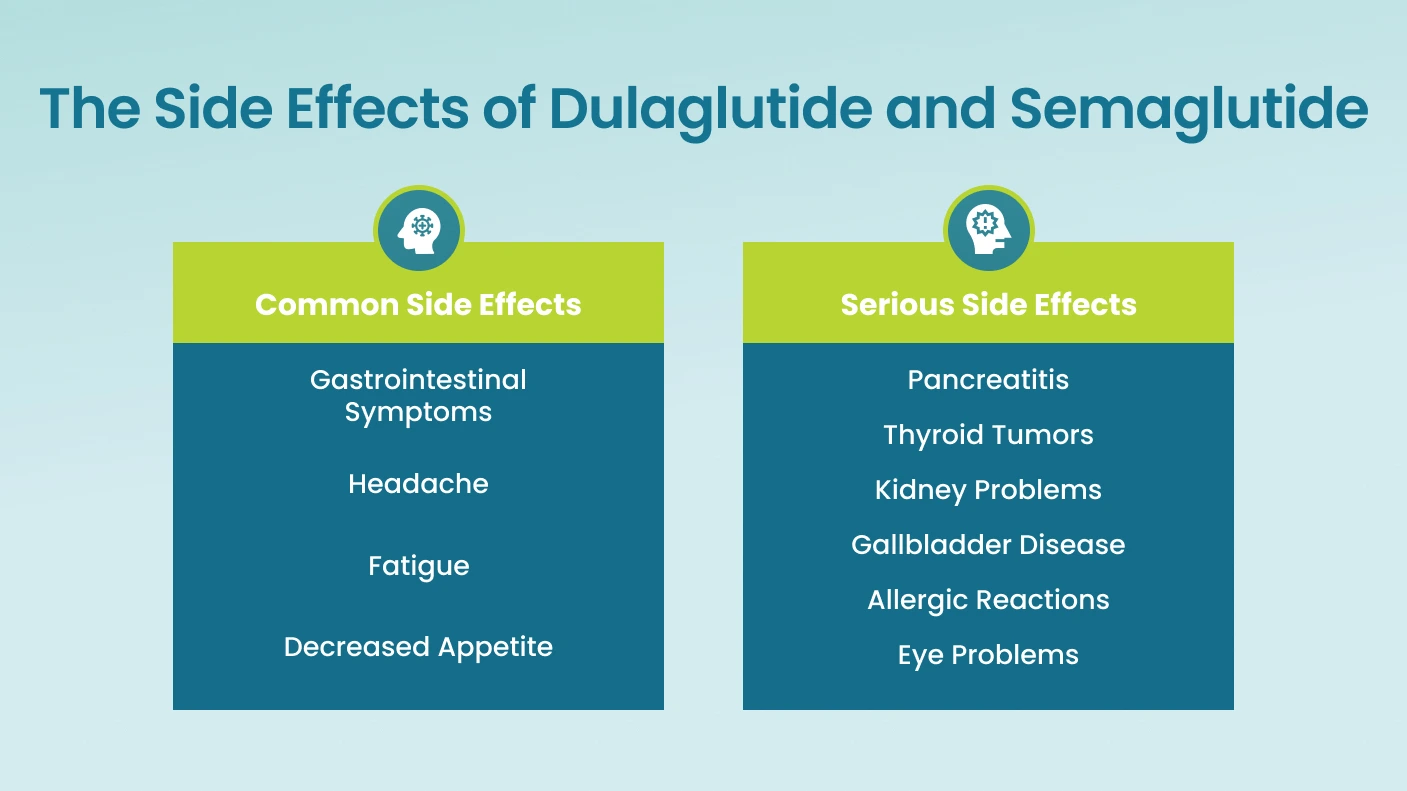
Dulaglutide vs Semaglutide for Weight Loss: Cost, Side Effects, & Dosage
Did you know that 43% of adults aged 18 and up are suffering from obesity worldwide? This is a clear indication that obesity has become a global problem.
This rising prevalence has increased the demand for effective weight-loss solutions, including lifestyle interventions and medical treatments. Among these, GLP-1 receptor agonists such as Dulaglutide and Semaglutide have gained significant attention for aiding weight loss and managing conditions like type 2 diabetes.
But how do these two medications compare when it comes to weight loss? Choosing the right one can feel overwhelming, from their costs and side effects to dosages and effectiveness. In this blog, we’ll compare Dulaglutide and Semaglutide in detail, giving you the insights you need to make an informed decision about your health journey.
What is Dulaglutide?
Dulaglutide, sold under the brand name Trulicity®, is a GLP-1 receptor agonist approved primarily for managing type 2 diabetes. Its ability to control blood sugar levels is a staple in diabetes care. Still, its benefits extend beyond diabetes, offering many patients modest yet impactful weight-loss results.
How Does It Work?
Dulaglutide mimics the effects of the GLP-1 hormone, which slows the movement of food from the stomach to the intestines (gastric emptying). It reduces appetite, making you feel fuller for longer, and helps regulate blood sugar by increasing insulin secretion and reducing glucagon production when glucose levels are high.
What is Semaglutide?
Semaglutide, marketed under Ozempic® (for diabetes) and Wegovy® (for weight loss), is another GLP-1 receptor agonist. It’s currently one of the most potent options for weight loss, often referred to as a breakthrough in obesity treatment.
How Does It Work?
Like Dulaglutide, Semaglutide mimics GLP-1 to slow digestion and suppress appetite. It’s considered more potent, resulting in more significant weight-loss outcomes and better blood sugar control.
The Major Differences Between Semaglutide and Dulaglutide

While semaglutide and dulaglutide belong to the same class of GLP-1 receptor agonists, they differ in their effectiveness, applications, and overall impact on weight loss and diabetes management. Here’s a closer look at the main differences:
Dulaglutide vs Semaglutide: Effectiveness for Weight Loss
Both dulaglutide and semaglutide have demonstrated significant results for weight loss in clinical trials, making them good options for individuals with obesity or overweight conditions, particularly when lifestyle changes alone aren’t enough.
However, the effectiveness of these two medications can vary.
Clinical Trial Data for Dulaglutide
The AWARD-11 trial explored the impact of different doses of dulaglutide (1.5 mg, 3.0 mg, and 4.5 mg) on body weight in patients with type 2 diabetes (T2D) who were inadequately controlled by metformin. The study showed that:
- Dulaglutide 3.0 mg led to a mean weight loss of −4.0 kg (approximately −4.2% of initial body weight) at 36 weeks.
- Dulaglutide 4.5 mg resulted in the most significant weight reduction, with −4.7 kg (about −4.9%) simultaneously.
- Dulaglutide 1.5 mg, the lowest dose, showed a more modest weight loss of −3.1 kg (approximately −3.2%).
These results suggest that higher doses of dulaglutide provide more substantial weight reduction, especially in patients with a higher baseline BMI. The percentage of weight loss also appears consistent across BMI subgroups, with patients experiencing greater absolute weight loss if they start with a higher weight.
Clinical Trial Data for Semaglutide
The STEP 1 trial focused on semaglutide 2.4 mg, which was tested in a population of adults with obesity (BMI ≥30) or overweight (BMI ≥27 with at least one comorbidity) without diabetes. The results were highly promising:
- Patients on semaglutide 2.4 mg achieved an average weight loss of −14.9% from baseline, or roughly −15.3 kg. This was significantly higher than the −2.4% weight loss in the placebo group.
- Over 86% of participants on semaglutide lost at least 5% of their body weight, and 69% lost 10% or more. Additionally, 50.5% of patients lost 15% or more of their body weight.
This level of weight loss is among the highest seen in clinical trials for anti-obesity drugs and reflects semaglutide’s effectiveness in promoting substantial and sustained weight loss.
Effectiveness
While clinical trials provide a controlled environment, the real-world effectiveness of dulaglutide and semaglutide often depends on factors such as patient adherence, lifestyle factors, and comorbidities.
- Dulaglutide: In real-world studies, the weight loss experienced by individuals on dulaglutide is typically consistent with clinical trial findings, with patients seeing around 3-5% weight loss over 6-12 months. However, results may vary based on individual responses and concurrent lifestyle modifications like diet and exercise. The effectiveness might be slightly lower than the clinical trial data due to factors like patient compliance and other health conditions.
- Semaglutide: Real-world data on semaglutide has also been favorable, though some studies suggest that weight loss may be slightly lower compared to clinical trials. While clinical trials show 14-15% weight loss, actual results suggest patients generally lose 8-12% of their body weight, especially in the first year of treatment. This can still represent a significant reduction, especially for those with obesity-related comorbidities like hypertension or type 2 diabetes.
Dosage and Administration: Dulaglutide vs Semaglutide
The dosage schedules and administration methods of dulaglutide and semaglutide differ, impacting patient preferences and adherence. Below is a breakdown of their dosage regimens and administration.
The Recommended Dose of Dulaglutide for Weight Loss
Starting Dose: The typical starting dose for weight loss in patients with type 2 diabetes or those with obesity (off-label) is 0.75 mg once weekly.
Titration: After 4 weeks, the dose can be increased to 1.5 mg once weekly to improve glycemic control and support weight loss.
Maximum Dose: The highest available dose is 4.5 mg once weekly, typically used for more significant weight loss results, especially in patients with type 2 diabetes.
Administration of Dulaglutide
Frequency: Dulaglutide is administered once a week, regardless of meals.
Route: Subcutaneous injection (under the skin), usually in the thigh, abdomen, or upper arm.
Injection Device: The medication is provided in a prefilled pen, simplifying administration.
Timing: The injection can be administered any day of the week, and patients can choose the most convenient day. The key is to take it once a week at the same time each week.
Missed Doses: If a dose is missed, the patient should take it as soon as they remember, as long as it is within 5 days of the scheduled dose. If more than 5 days have passed, the missed dose should be skipped, and the regular dosing schedule should resume.
The Recommended Dose of Semaglutide for Weight Loss
Starting Dose: The initial dose for weight loss with semaglutide is 0.25 mg once weekly for 4 weeks. This low dose helps to minimize gastrointestinal side effects.
Titration: The dose is gradually increased to allow the body to adjust. After 4 weeks at 0.25 mg, the dose is increased to:
- 0.5 mg once weekly for 4 weeks,
- 1 mg once weekly for 4 weeks,
- 1.7 mg once weekly for 4 weeks,
- Finally reaching 2.4 mg once weekly for long-term maintenance.
Maximum Dose: The highest recommended dose for weight loss is 2.4 mg once weekly. This is the dose used in clinical trials like the STEP 1 trial, which observed significant weight loss results.
Administration of Semaglutide
Frequency: Semaglutide is administered once a week as a subcutaneous injection and can be taken any day.
Route: Subcutaneous injection, similar to dulaglutide. Patients are encouraged to rotate the injection site between the thigh, abdomen, or upper arm.
Injection Device: Semaglutide is delivered via a prefilled pen injector, making it easier for patients to administer at home.
Timing: Patients are advised to take semaglutide on the same day each week, regardless of meal timing.
Missed Doses: If a dose is missed and it has been less than 5 days since the scheduled dose, the patient should take it as soon as possible. If more than 5 days have passed, skip the missed dose and resume the regular weekly schedule.
The Side Effects of Dulaglutide and Semaglutide

Dulaglutide and semaglutide are generally well tolerated, but like all medications, they can have side effects. These side effects are often related to the gastrointestinal system, as both drugs mimic the effects of the GLP-1 hormone, which can slow gastric emptying and suppress appetite. Understanding the potential side effects of both medications is important for patients to manage expectations and discuss any concerns with their healthcare provider.
Common side effects of dulaglutide and semaglutide include:
Gastrointestinal Symptoms
Nausea: One of the most common side effects, especially when starting treatment or when the dose is increased. Nausea is usually mild to moderate and often subsides as the body adjusts.
Diarrhea: This can occur, particularly during the initial stages of treatment.
Vomiting: Less common but can occur, particularly if nausea is severe.
Abdominal pain: Some patients may experience discomfort in the abdomen.
Headache:This is a frequent complaint among users, especially in the first few weeks of treatment.
Fatigue: Tiredness or fatigue is common during the early phases of treatment.
Decreased Appetite: A GLP-1 agonist helps reduce appetite, which is generally seen as beneficial in patients aiming for weight loss. However, for some, the reduction in appetite can feel more intense and lead to reduced food intake.
Serious Side Effects of Dulaglutide and Semaglutide
Some serious side effects of dulaglutide and semaglutide include:
Pancreatitis
Though rare, acute pancreatitis is a potential risk with semaglutide and dulaglutide, as with other GLP-1 agonists. Symptoms of pancreatitis include persistent stomach pain, nausea, and vomiting. Patients should seek immediate medical attention if these symptoms occur.
Thyroid Tumors
Semaglutide carries a risk of thyroid tumors in animals. Medullary thyroid carcinoma (MTC) and thyroid C-cell hyperplasia have been observed in rodents, but there is no conclusive evidence that semaglutide causes thyroid cancer in humans. However, patients with a family history of thyroid cancer or multiple endocrine neoplasia type 2 (MEN 2) should not use semaglutide.
Kidney Problems
Dulaglutide and semaglutide may lead to or exacerbate kidney issues, especially in individuals who experience significant gastrointestinal side effects such as dehydration from vomiting or diarrhea.
Gallbladder Disease
The medications have been linked to a higher incidence of gallstones and other gallbladder issues, particularly in patients with a history of gallbladder disease. Symptoms to watch for include pain in the upper right abdomen.
Allergic Reactions
Severe allergic reactions are rare but possible. Symptoms may include swelling of the face, lips, tongue, or throat and difficulty breathing, which could indicate a serious allergic reaction.
Eye Problems
Some individuals with diabetic retinopathy (a condition associated with diabetes) have reported worsening eye problems when using dulaglutide and semaglutide. This is a concern mainly in those with existing eye issues related to diabetes.
Managing Side Effects
While side effects are common with both dulaglutide and semaglutide, most are mild and transient, especially when the body adjusts to the medication. Patients should communicate regularly with their healthcare providers to monitor and manage these side effects. In many cases, dose adjustments or slow titration can help reduce the severity of gastrointestinal issues.
Additionally, staying hydrated, maintaining a balanced diet, and following the prescribed administration schedule can minimize discomfort and maximize the benefits of these medications.
If any serious side effects, such as symptoms of pancreatitis, allergic reactions, or signs of thyroid issues, occur, patients should immediately contact their healthcare provider.
Start Your Weight Loss Journey with IV Drips!

At IV Drips, we offer weight loss programs tailored to help you reach your goals through sustainable weight management, improved health, and an enhanced quality of life. Our team of dedicated professionals combines expert guidance, advanced treatments, and holistic wellness practices to support you every step of the way.
Why Choose Us?
- Personalized Weight Loss Strategies: Each plan is customized to fit your health goals and lifestyle, ensuring results that meet your unique needs.
- IV Drip Therapy for Targeted Fat Support: Our IV drips deliver essential nutrients that enhance metabolism, aid recovery, and boost energy levels, making your journey to a leaner, healthier physique smoother and more efficient.
- Access to Semaglutide: FDA-approved medications like semaglutide offer effective medical support for weight loss, helping manage appetite and support metabolic health.
- Expert Medical Supervision: Your weight-loss journey is guided by qualified physicians who monitor every aspect of your treatment for safety and optimized results.
- Comprehensive Wellness Support: From nutritional guidance to lifestyle adjustments, our holistic approach ensures you have expert advice and support at each stage.
- Proven Health Solutions: We combine leading medical treatments like IV drips and weight-loss medications with holistic practices for a complete approach to effective weight management.
Ready to start your journey toward a healthier life? Start your weight loss journey today!
Posted on behalf of IVDrips









